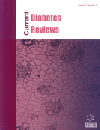- Home
- A-Z Publications
- Current Diabetes Reviews
- Previous Issues
- Volume 9, Issue 2, 2013
Current Diabetes Reviews - Volume 9, Issue 2, 2013
Volume 9, Issue 2, 2013
-
-
Glucagon Like Peptide-1 (GLP-1) Dynamics Following Bariatric Surgery: A Signpost to a New Frontier
More LessAuthors: K. J. Neff, D. O'Shea and C. W. le RouxGlucagon like peptide-1 (GLP-1) is one of the gastrointestinal peptides implicated in glycaemic homeostasis. In non-obese individuals with normal glucose tolerance GLP-1 is secreted in response to nutrient intake. However, this GLP- 1 response is generally accepted to be significantly diminished in those with diabetes, obesity or both. Given that GLP-1 is secreted from enteroendocrine L cells in the intestine, it is not sur Read More
-
-
-
Insulin and the Brain
More LessAuthors: Fatemeh Derakhshan and Cory TothMainly known for its role in peripheral glucose homeostasis, insulin has also significant impact within the brain, functioning as a key neuromodulator in behavioral, cellular, biochemical and molecular studies. The brain is now regarded as an insulin-sensitive organ with widespread, yet selective, expression of the insulin receptor in the olfactory bulb, hypothalamus, hippocampus, cerebellum, amygdala and cerebral cortex. Insulin Read More
-
-
-
TRPM Channels Phosphorylation as a Potential Bridge Between Old Signals and Novel Regulatory Mechanisms of Insulin Secretion
More LessAuthors: Carlos Manlio Diaz-Garcia, Carmen Sanchez-Soto and Marcia HiriartTransient receptor potential channels, especially the members of the melastatin family (TRPM), participate in insulin secretion. Some of them are substrates for protein kinases, which are involved in several neurotransmitter, incretin and hormonal signaling cascades in β cells. The functional relationships between protein kinases and TRPM channels in systems of heterologous expression and native tissues rise issues about nov Read More
-
-
-
Is Whole-Body Thermoregulatory Function Impaired in Type 1 Diabetes Mellitus?
More LessAuthors: Jane E. Yardley, Jill M. Stapleton, Michael R. Carter, Ronald J. Sigal and Glen P. KennyDuring periods of extreme heat individuals with diabetes have greater rates of heat-related morbidity and mortality compared to their non-diabetic counterparts. The reason for this discrepancy is currently unknown. Furthermore, there is a lack of information about whether or not individuals with type 1 diabetes are at a thermoregulatory disadvantage during strenuous physical activity especially when performed in the heat. P Read More
-
-
-
New Player on An Old Field; the Keap1/Nrf2 Pathway as a Target for Treatment of Type 2 Diabetes and Metabolic Syndrome
More LessAuthors: Dionysios V. Chartoumpekis and Thomas W. KenslerNuclear erythroid factor 2 like 2 (Nrf2) has been described as a transcription factor that serves as a master regulator of the adaptive response to exogenous and endogenous oxidative and electrophilic stresses. Evidence of Nrf2 crosstalk with other molecular pathways is increasing; recent publications have proposed a role of Nrf2 in the development of obesity and in the highly regulated process of adipocyte differentiation t Read More
-
-
-
Diabetic Retinopathy and Atherosclerosis: is there a Link?
More LessDiabetic retinopathy (DR) is the leading cause of blindness amongst the working-age population, and diabetes accelerated cardiovascular disease (CVD) the commonest cause of death in diabetic patients. Although, there is evidence suggesting a close association between DR and CVD, particularly in patients with Type 2 diabetes, the pathophysiology underlying the link is unclear. Here we review common risk factors and Read More
-
-
-
Evolution of Exenatide as a Diabetes Therapeutic
More LessAuthors: Sunil Bhavsar, Sunder Mudaliar and Alan CherringtonType 2 diabetes (T2DM) is a disease of epidemic proportion associated with significant morbidity and excess mortality. Optimal glucose control reduces the risk of microvascular and possibly macrovascular complications due to diabetes. However, glycemic control is rarely optimal and several therapeutic interventions for the treatment of diabetes cause hypoglycemia and weight gain; some may exacerbate cardiovasc Read More
-
Volumes & issues
-
Volume 21 (2025)
-
Volume 20 (2024)
-
Volume 19 (2023)
-
Volume 18 (2022)
-
Volume 17 (2021)
-
Volume 16 (2020)
-
Volume 15 (2019)
-
Volume 14 (2018)
-
Volume 13 (2017)
-
Volume 12 (2016)
-
Volume 11 (2015)
-
Volume 10 (2014)
-
Volume 9 (2013)
-
Volume 8 (2012)
-
Volume 7 (2011)
-
Volume 6 (2010)
-
Volume 5 (2009)
-
Volume 4 (2008)
-
Volume 3 (2007)
-
Volume 2 (2006)
-
Volume 1 (2005)
Most Read This Month
Article
content/journals/cdr
Journal
10
5
false
en


